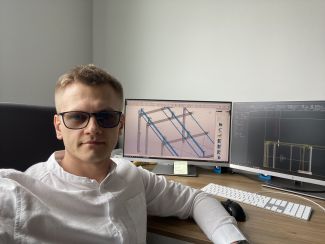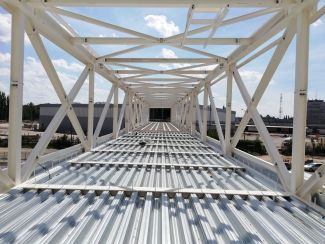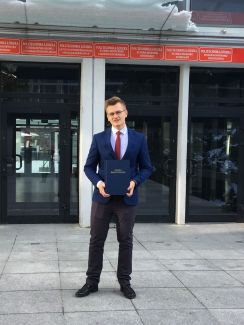You are an excellent example of a student combining education with industrial experience. How do you see the benefits of this?
I can undoubtedly see a two-way benefit here. Continuous activity and professional development are a source of inspiration for new research activities. It also creates the possibility of more or less direct implementation of research results, which additionally motivates me to continue research work.
How do your research objectives fit in with global reports on construction research?
To this day, in situ testing of building structures such as large-scale halls is rare. It is therefore important from my point of view to acquire the ability to estimate very accurately the dynamic phenomena of structures with the use of computer assistance. One of my research objectives is to develop a method of implementation of the Generalized Stochastic Perturbation Method in the dynamics of selected steel structures, so that the results obtained provide comparable accuracy of determining the reliability of the structure in relation to other probabilistic methods, which require much more computational power of the computer, and thus are less accessible.
A parallel objective is also to carry out a dynamic reliability sensitivity analysis of selected steel structures with respect to tested design parameters treated as random. In order to achieve the above objectives, I am planning to go for a few months’ scientific internship to the University of Messina, where I would have the opportunity to learn other tools for stochastic structural mechanics. I also plan to participate in the competition held by the National Agency for Academic Exchange (NAWA) within the Bekker Scholarship edition, which will help me to realise my research plan to be carried out in a foreign institution.
What kind of constructions do you deal with?
The subject of my current research is steel structures such as a mast with lashings, a steel hall with variable stiffness sections. The analysis of a lattice tower is also planned. These are undoubtedly common structures, some in telecommunications and others in the form of storage areas, logistics centres and others. Their common feature is their relative slenderness and thus lightness, but they are expected to be geometrically unchanging because of the need to fulfil their basic functions. It is interesting, if only from this point of view, to consider time-varying environmental stimuli such as the aforementioned dynamically acting wind.
However, in my professional activity I am not limited to designing steel structures as they are commonly found together with elements made of concrete reinforced with steel rods (reinforced concrete elements). One example is reinforced concrete footings which support steel columns. Warehouse or logistic facilities with a hybrid structure, i.e. with reinforced concrete columns and a steel roof structure, are also common in design and subsequent implementation. Hall structures are built in this form because of fire safety requirements.
Why is it so important to take account of changes in factors over time?
It is easy to find video footage of a bridge span failing due to winds close to the natural frequency of the span. Another example that comes to mind is when a stadium stand is vibrated by periodic movement or jumping of the audience. The examples given here are undoubtedly extremes, but nevertheless there are many stimuli causing vibrations in structural systems. Furthermore, the effects of repetitive excitation of the structure can also cause slow degradation processes leading to fatigue and failure. Dynamic analyses are more complex and more difficult to implement, so in practice the loads acting dynamically on the structure are often reduced to some static equivalent (quasi-static load). One of the risks of such a calculation approach is the risk of not identifying the phenomenon of excitation of the structure, which in reality will be exposed to dynamic load with a frequency close to the frequency of natural vibrations of the structure (or its certain multiplication), so that the deformation and stress state estimated by the design may not reflect the real working conditions of the structure.
Which professional challenge do you consider the most important so far?
One of the first tasks, which I definitely still consider a big challenge, was the assembly of a spatial truss system consisting of three segments, running over a street (closed to traffic for the time of assembly). Each had cross-sectional dimensions of at least 6.5 m x 5.8 m (W x H), and the largest, 36.0 m long, lifted in its entirety to its final location, weighed more than 64,000 kg. The total
length of the structure was 84.0 m and the total weight exceeded 176,000 kg. The structure was installed at the target site in three lifts, each from a different crane position.
Which factors need to be considered before building a structure?
One of the key characteristics of building structures is that they should be able to fulfil their design life with an appropriate level of safety/security. For a structural system to provide an appropriate level of safety, many factors need to be considered, often highly dependent on the type of structure. Certainly, however, the correct identification of soil parameters, the location of the facility in terms of geographical coordinates, the orography of the terrain, the mechanical properties of the construction material or factors causing material degradation such as corrosion processes are parameters that must be considered in the design.
Can any structure be built anywhere?
I believe that one of the most interesting challenges for an engineer is to try to place a structure in a location where no one has attempted to erect it before, or a type of structure that is unique because of its form/shape or function. Modern methods and tools supporting the computer modelling of structures, as well as supporting the creation of their mathematical models, make it possible to constantly make such attempts.
I admire unique technical solutions and unique constructions in general. They often become the pride of a city, region or even country. Naturally, in the investment and construction process, economic factors are also taken into account in the decision-making process for most construction projects.
Why is it worth being a scientist?
I believe that scientific development gives me the opportunity to be a better engineer every day. I have the opportunity to test and implement new ideas and research results in professional realities. Continuous professional activity, in turn, stimulates my curiosity and provides new challenges worth exploring further. I could say that, from my point of view, it is worth being a scientist to maintain balance, not fall into a routine and constantly improve in my profession.



